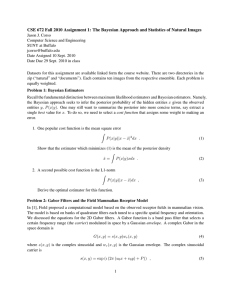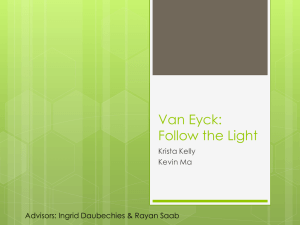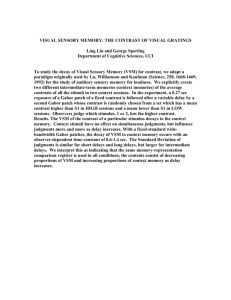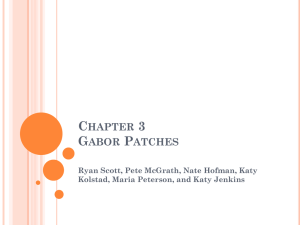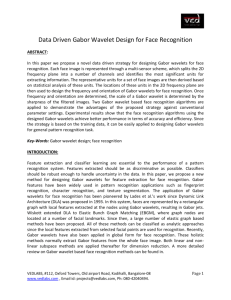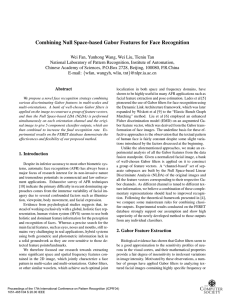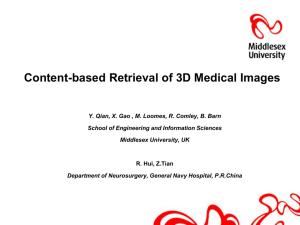Detection of asymmetric eye action units in spontaneous videos Please share
advertisement
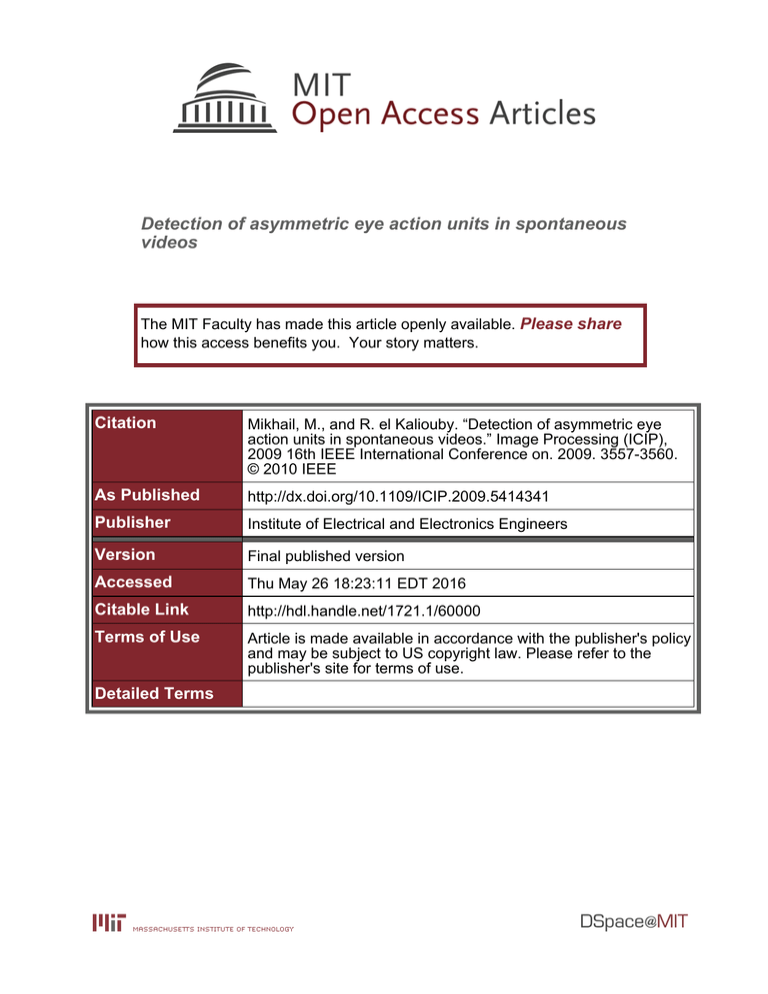
Detection of asymmetric eye action units in spontaneous
videos
The MIT Faculty has made this article openly available. Please share
how this access benefits you. Your story matters.
Citation
Mikhail, M., and R. el Kaliouby. “Detection of asymmetric eye
action units in spontaneous videos.” Image Processing (ICIP),
2009 16th IEEE International Conference on. 2009. 3557-3560.
© 2010 IEEE
As Published
http://dx.doi.org/10.1109/ICIP.2009.5414341
Publisher
Institute of Electrical and Electronics Engineers
Version
Final published version
Accessed
Thu May 26 18:23:11 EDT 2016
Citable Link
http://hdl.handle.net/1721.1/60000
Terms of Use
Article is made available in accordance with the publisher's policy
and may be subject to US copyright law. Please refer to the
publisher's site for terms of use.
Detailed Terms
DETECTION OF ASYMMETRIC EYE ACTION UNITS IN SPONTANEOUS VIDEOS
Mina Mikhail
Rana el Kaliouby
American University in Cairo
Computer Science Department
113 Kasr Al Aini Street
Cairo, Egypt
minamohebn@gmail.com
Massachusetts Institute of Technology
Media Laboratory
20 Ames Street
Cambridge MA 02139 USA
kaliouby@media.mit.edu
ABSTRACT
With recent advances in machine vision, automatic detection
of human expressions in video is becoming important especially because human labeling of videos is both tedious and
error prone. In this paper, we present an approach for detecting facial expressions based on the Facial Action Coding System (FACS) in spontaneous videos. We present an automated
system for detecting asymmetric eye open (AU41) and eye
closed (AU43) actions. We use Gabor Jets to select distinctive
features from the image and compare between three different classifiers—Bayesian networks, Dynamic Bayesian networks and Support Vector Machines—for classification. Experimental evaluation on a large corpus of spontaneous videos
yielded an average accuracy of 98% for eye closed (AU43),
and 92.75% for eye open (AU41).
Index Terms— Gabor Jets, Dynamic Bayesian Networks
(DBN), Support Vector Machines (SVM), Action Units (AU),
Spontaneous video
1. INTRODUCTION
Over the past decade there has been an increasing surge of
interest in automated facial expression analysis. The majority of these efforts describe facial movements using the Facial
Action Coding System (FACS) [1], a catalogue of 44 unique
action units (AUs) that correspond to each independent motion of the face. It also includes several categories of head and
eye movements. FACS enables the measurement and scoring of facial activity in an objective, reliable and quantitative
way. It can also be used to discriminate between subtle differences in facial motion. For these reasons, it has become the
leading method in measuring facial behavior. Human trained
FACS coders are very adept at picking subtle or fleeting facial actions, which communicate a wide range of information
including when a person is lying, depressed, or about to have
an epileptic seizure. However, FACS-coding requires extensive training and is a labor intensive task. It takes almost 100
hours of training to become a certified coder, and between one
to three hours of coding for every minute of video.
978-1-4244-5654-3/09/$26.00 ©2009 IEEE
3557
The range of potential applications of automated facial
analysis systems, coupled with the labor intensive requirements of human FACS-coding, has provided the main thrust
for this area of research. In this paper, we address the problem of detecting asymmetric eye open (AU41) and eye closed
(AU43) action units. Applications include driver state monitoring and health application monitoring such as detection of
epileptic seizures which is often accompanied with asymmetric blinking. We tested our approach on a large number of
spontaneous images.
The paper advances the state-of-the-art in facial action
unit classification in three ways: (1) Accurate detection of
spontaneous eye movements in the presence of substantial
head motion and changes in lighting conditions; (2) our approach uses Gabor Jets to generate our feature vector and
compares three different classifiers in accuracy; (3) testing
and training on thousands of spontaneous images that have
little or no control on accompanying head motion and lighting. Our approach can be generalized and applied to detect
other AUs such as nose wrinkle (AU9), mouth AUs, as well
as asymmetric cheek raiser (AU6) and others.
2. RELATED WORK
Bartlett et al [2] present one of the most successful systems
for detecting AUs using Gabor filters followed by support
vector machines (SVMs). Faces are first localized, scaled to
96x96 pixels and then passed through a bank of Gabor filters
before classification. The accuracy of AU detection decreases
as the training sample decreases. Vural et al [3], improved the
work done by Bartlett et al. [2] by retraining the system on
a larger dataset. They reached an accuracy of 93% on posed
images and 75% on spontaneous images. Tian et al. [4] detect
eye state AUs for frontal images by applying Gabor filters on
three points of each eye and then feed the results of the Gabor
filters into a neural network.
This paper extends eye state detection by accurately detecting eye states in thousands of spontaneous images with
substantial degrees of head motion and changes in the light-
ICIP 2009
Right eye
Right eye
Right eye
features Binary Classifier Decision
Left eye
Left eye
features
Extracting
Eye Region
(BN/DBN/SVM)
Gabor Jets
Left eye
Decision
these features can be used to characterize the underlying texture information [5].
Asymmetry
check
Fig. 1. Multi-level approach for asymmetric AU detection.
ing. We also propose the use of Bayesian Networks and
SVMs instead of using Neural Networks, resulting in a huge
boost in accuracy that reaches up to 98% for AU43 and 93%
for AU41, instead of 83% reported in Tian et al. [4].
3. APPROACH
As shown in Fig. 1, we present a multi-level approach to detect asymmetric eye open or eye closed AUs in video. Since
the purpose of this research is to differentiate between eye
open and eye close, there was no need to extract all the facial features and train the eye open/close classifier on features
that are not related to the eye. For every incoming frame of
the video, we first locate the left and right eye regions. The regions are then passed through a bank of Gabor Jets, which are
then fed into a classifier. We used three different classifiers
for comparison: static Bayesian network, Dynamic Bayesian
Network (DBN) and support vector machines (SVM). Congruency between classification results of the left eye and right
eye determines the presence of asymmetry or not.
4. EYE REGION LOCALIZATION
In order to detect faces in an image, we used Google’s facetracker. The tracker uses a generic face template to bootstrap
the tracking process, initially locating the position of 22 facial
land-marks including the eyes, mouth, eyebrows and nose.
We use the eye brow, inner and outer eye corner feature points
to locate the eye region as shown in Fig. 2. From each frame,
we extract two images representing the left and right eyes.
The eye brow feature point represents the maximum Y coordinate for each eye image. The minimum Y coordinate is the
reflection of the eye brow feature point on right pupil feature
point. The inner and outer eye corner feature points represent
the maximum and minimum X for the eye rectangle.
5. FEATURE EXTRACTION
After generating the eye images from the video frames, we
wanted to extract features from these images to be used in
our classification. Since the videos have substantial degrees
of head motions which give different scales and orientations
for the face, we decided to use Gabor filters. Gabor filters
convolves the image with a Gaussian function multiplied by
a sinusoidal function. The Gabor filters are considered to be
orientation and scale tunable edge detector. The statistics of
3558
Fig. 2. The result of locating the right eye and left eye from
the frame using facial feature points.
One major disadvantage of Gabor filters is that it is computationally expensive, making it difficult to be applied in
real-time applications [6]. To detect video images in realtime, we decided to use Gabor Jets which describe the local
image contrast around a given pixel in angular and radial directions [6]. Gabor Jets are characterized by the radius of the
ring around which the Gabor computation will be applied. We
chose the center of our Gabor Jets to be the center of pupil.
So an image of 3x3, as shown in Fig. 3, is passed to the Gabor
filters with 4 scales and 6 orientations to generate 216 features
representing the magnitude of the Gabor filters.
6. CLASSIFICATION
In order to train our classifiers, we chose 80 eye left images
captured from spontaneous videos. 40 out of the 80 images
were a representative set of eye open and the other 40 were
representative set of the eye closed. We experimented our
approach with three different classifiers.
6.1. Static Bayesian Network
We created a Bayesian Network for detecting the eye open or
eye closed AU. The Bayesian Network is defined by number
of hidden states (N) and number of observed states (M) and
number of parameters λj = (π,A):
• N, the number of states in the model S = {S1 , ..., SN };
S1 is a discrete hidden node representing whether the
eye is open or closed. S2 , S3 , ..., SN are continuous
observed states representing the Gabor Jets generated
features;
• A= {aij }, is an N x N matrix to represent the topology
of the network where aij = 1 indicates an edge from
node i to node j. The structure of our Bayesian Network
is shown in Fig. 4;
• πi is the probability of state i in case of a discrete node
or the mean and variance of state i in case of a continuous node.
Table 1. Results of applying the three classifiers to the eye
images.
AU
# images
Open
Closed
1919
150
2069
BN
True
1780
147
1927
DBN
True
1780
147
1927
%
92.7
98
93.1
SVM
True
1809
140
1949
%
92.7
98
93.1
%
94.3
93.3
94.2
100
Fig. 3. The figure represents the selected (Gabor Jets) where
we are applying Gabor filter on.
99
98
97
96
Bnet
95
DBN
94
Eye open/closed
SVM
93
92
91
90
Parcipant 1
Feature 1
Feature 2
Fig. 4. The structure of the Bayesian Network used to infer
the presence of eye open/closed AU.
Parcipant 3
n
Fig. 5. Accuracy of applying the three classifiers to three different participants
points in different classes [7]. We trained one SVM for detecting eye open or eye closed. In our research we experimented
with linear kernels and compared the results of applying SVM
with the results obtained from static Bayesian Networks and
Dynamic Bayesian Networks.
The probability of eye open is defined by
P (X1 , X2 , X3 , ..., Xn ) =
Parcipant 2
Feature 216
P (Xi |parents(Xi ))
i=1
7. EXPERIMENTAL EVALUATION
6.2. Dynamic Bayesian Network (DBN)
In order to make use of the temporal relations between AUs,
we experimented with Dynamic Bayesian Networks instead
of static Bayesian networks. DBNs are defined in the same
way like static Bayesian network with some extra parameters.
First, we have to define the inter relation between the different
time slices. In our case, we found that our hidden node at time
t is dependent only on the hidden node at t-1. The model is
given by the joint probability distribution:
P (Xi , Y, Θ) = P (Y |Xi , BΦ )P (Xi |A, Π)
Where Θ represents the number of time slice and the observation function BΦ is parameterized by the conditional
probability distribution that model the dependency between
the two nodes. We detected the desired AU based on 5 previous time slices.
7.1. Classification Results
We have created a large database of images taken from spontaneous videos with an average duration of thirty minutes.
The videos used for testing are from a sip study that Affective Computing at MIT Media Laboratory conducted in collaboration with major beverage company. Each participant is
seated in front of a laptop (with a built-in webcam) and given
a choice of two beverages that were located on the left and
right of the laptop.
We used different images for testing than those used for
training. The chosen images have head pitches which range
from -9.2 to 12.23 degrees, head yaws which range from Eye open
Eye closed
100
100
95
95
90
90
Bnet
Bnet
DBN
DBN
SVM
SVM
85
6.3. Support Vector Machines (SVMs)
80
75
70
Another classifier that was experimented with is an SVM classifier. SVMs view the input data, 216 Gabor Jet features, as
two sets of vectors in a 216-dimensional space. SVM will
construct a separating hyperplane in that space that maximizes the margin between the two data sets. A good hyperplane will be the one that has the highest distance to different
3559
Bnet
Bnet
DBN
DBN
SVM
SVM
85
80
75
70
65
65
60
60
le
eyeeye
openopen
Left
Right eyeeye
openopen
Right
Le eye
closed
Left
eye
closed
Right eye
closed
Right
eye
closed
Fig. 6. Accuracy of applying the three classifiers, trained on
the left eye images, to the left and right eye of the same participant.
Fig. 7. Lower action units: chin raiser (AU17), mouth open
(AU27), cheek puffer (AU13). Upper action units: nose wrinkler (AU9), cheek raiser (AU6), frown (AU2)
16.8 to 26.9 and head rolls which range from -5.0 to 7.0. We
tested our methodology on 2100 images and Table 1 shows
the accuracy of applying the three different classifiers on eye
open and eye closed images. It is obvious that the accuracy of
the DBN is the same like that of the BN. This is because the
hidden node is dependent on 216 observed node in case of BN
and 221 observed nodes in case of the DBN which includes
the Gabor features and the five temporal nodes of the previous
time slices. The effect of the extra five nodes, in case of the
DBN, will have a minor effect on probability of the hidden
node compared to the other 216 nodes.
To ensure that our approach is general and can be used on
participants that the classifier is not trained on, we tested on
three participants whose images are not used in the training.
Fig. 5 shows the accuracy of the three classifiers for each participant. The images that were selected for training were extracted from the video of the first participant only. However,
we used different images from the video of the first participant
for testing.
We also, trained our classifiers on left eye images only and
used 400 right eye images for testing on the same classifier to
make sure that we do not need a separate classifier for the
right eye. The results of applying the classifier on the right
eye images shown in Fig. 6 shows that our classifiers work
well even if they are trained on left eye images only.
7.2. Discussion
Our methodology depends mainly on the accuracy of the
tracker. Since the center of the Gabor Jet is determined by one
of the feature points generated by the tracker, any substantial
drift in this feature point will result in misclassification of the
eye images.
Our approach can be easily generalized to detect other
AUs as shown in Fig. 7. For instance, we can easily detect
mouth open (AU27) by making the center of the Gabor Jets
in the center of the mouth. We can also, detect the presence
of a frown (AU2) by making the center of the Gabor Jets at
the center of the forehead.
8. CONCLUSION
This paper describes a methodology for differentiating between eye open (AU41) and eye closed (AU43). Detecting
such AUs is important for different applications such as driver
3560
state monitoring and health application monitoring. We presented the results of applying three different machine learning
classifiers on Gabor Jets features. We reached an average accuracy of 98% for eye closed and 93% for eye open. Our
next step is to test our methodology on different AUs such as
mouth closed and mouth stretch. And in order to account for
the inaccuracy of the tracker feature point, we will work on
increasing the size of Gabor Jets to 5x5 or 7x7 or 9x9. This
will require using a feature extraction algorithm such as Adaboost in order to reduce the training and inference time and
to be able to apply our approach in real-time.
9. ACKNOWLEDGMENTS
The authors would like to thank Hyungil Ahn and Rosalind
W. Picard for making the corpus available for this work.
The authors would also like to thank Ahmed Sameh, Joshua
Gluckman for their help in this research and Google for
making the face tracker available to our research.
10. REFERENCES
[1] P. Ekman, W.V. Friesen, J.C. Hager, and A.H. Face, “Facial Action Coding System,” 1978.
[2] M.S. Bartlett, G.C. Littlewort, M.G. Frank, C. Lainscsek, I. Fasel, and J.R. Movellan, “Automatic recognition
of facial actions in spontaneous expressions,” Journal of
Multimedia, vol. 1, no. 6, pp. 22–35, 2006.
[3] E. Vural, M. Çetin, A. Erçil, G. Littlewort, M. Bartlett,
and J. Movellan, “Machine Learning Systems For Detecting Driver Drowsiness,” in Proceedings of the Biennial
Conference on Digital Signal Processing for in-Vehicle
and Mobile Systems, 2007.
[4] Y. Tian, T. Kanade, and J.F. Cohn, “Eye-state action unit
detection by gabor wavelets,” Lecture notes in computer
science, pp. 143–150, 2000.
[5] W. Y. Ma and B. S. Manjunath, “Texture features and
learning similarity,” in IEEE Conf. on Computer Vision
and Pattern Recognition, 1996, pp. 425–430.
[6] U. Hoffmann, J. Naruniec, A. Yazdani, and T. Ebrahimi,
“Face Detection Using Discrete Gabor Jets and Color Information,” in International Conference on Signal Processing and Multimedia Applications, 2008, pp. 76–83.
[7] S.R. Gunn, “Support Vector Machines for Classification
and Regression,” ISIS Technical Report, vol. 14, 1998.
